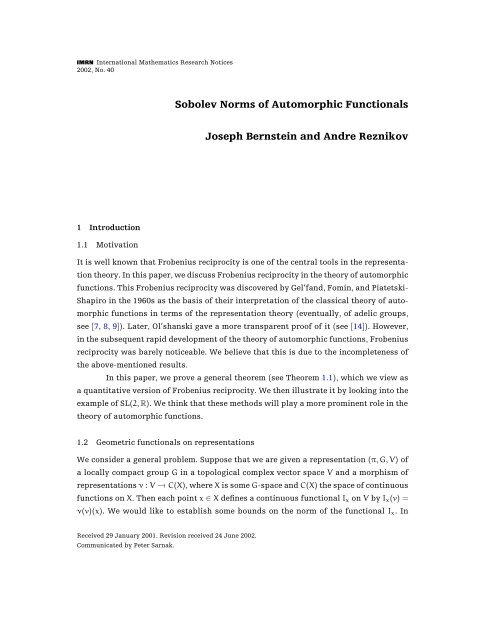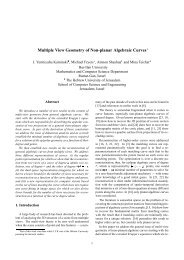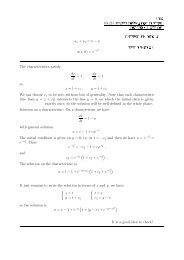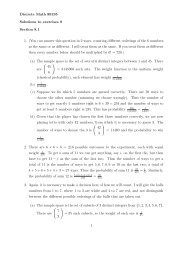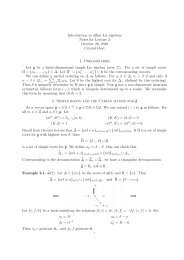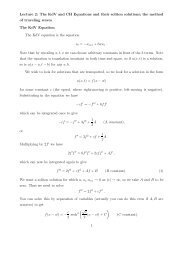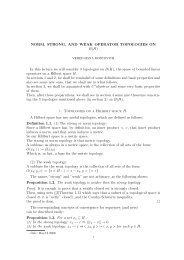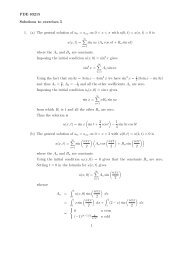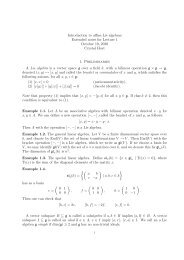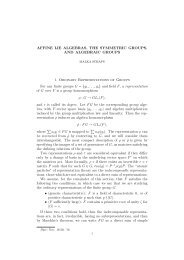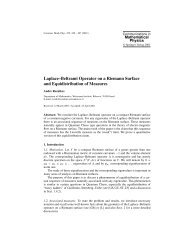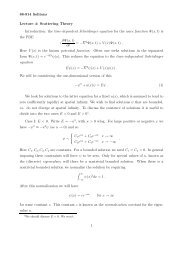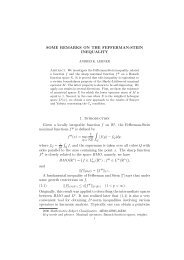Sobolev Norms of Automorphic Functionals - School of ...
Sobolev Norms of Automorphic Functionals - School of ...
Sobolev Norms of Automorphic Functionals - School of ...
Create successful ePaper yourself
Turn your PDF publications into a flip-book with our unique Google optimized e-Paper software.
2158 J. Bernstein and A. Reznikov2 <strong>Automorphic</strong> functions on SL(2, R)Here we implement our strategy for G = SL(2, R). We make this section self-contained inorder to make the paper more accessible (hence some overlap with the previous section).2.1 SettingLet H be the upper half plane with the hyperbolic metric <strong>of</strong> constant curvature −1. Thegroup G = SL(2, R) acts on H by isometries.We fix a discrete group Γ ⊂ G. Consider the Riemann surface Y = Γ \H; we assumethat Y is compact. Denote by D the Laplace-Beltrami operator acting in the space <strong>of</strong>functions on Y. We denote by 0 = µ 0
2160 J. Bernstein and A. ReznikovNote that the dual space <strong>of</strong> W s is naturally isomorphic to the <strong>Sobolev</strong> spaceW −s (Ṽ) <strong>of</strong> the contragradient representation (˜π, Ṽ) (in the case <strong>of</strong> SL(2, R) we can identify˜π with π). Hence, we can consider the automorphic functional I as a distribution vectorin the representation ˜π, and the question above is a question to which <strong>Sobolev</strong> spacesW s (˜π) this vector belongs.In fact we can also ask the same question about the regularity <strong>of</strong> the functionalI with respect to other classes <strong>of</strong> spaces, for example, L p -<strong>Sobolev</strong> spaces, Besov spaces,Hölder spaces, and so on.Several recent papers deal with this question for different regularity classes, see[18] for Hölder spaces and [6] for L p <strong>Sobolev</strong> spaces.The main point <strong>of</strong> this paper is that in the case <strong>of</strong> L 2 <strong>Sobolev</strong> norms we can geta very simple answer, which is a special case <strong>of</strong> Theorem 1.1.Theorem 2.1. Let Γ ⊂ G be a cocompact discrete subgroup, (π, V) an irreducible automorphicrepresentation, and I the corresponding automorphic functional. Then s-<strong>Sobolev</strong> norm <strong>of</strong> the functional I is bounded if and only if s > 1/2.□In fact, our method shows that this is true for all infinite dimensional automorphicrepresentations <strong>of</strong> G and the corresponding functionals I.We can restate Theorem 2.1 as a bound on automorphic functions (for a cocompactsubgroup). Let ‖φ‖ ∞ = sup x∈X |φ(x)| be the supremum norm on C(X). We introducethe norm N ∞ on the space V λ by N ∞ (v) =‖ν(v)‖ ∞ for v ∈ V λ . Then Theorem 2.1 amountsto the boundN ∞ ≤ CN s , (2.1)on the space V λ .In practice, Theorem 1.1 gives more and we prove, in fact, that the functional Iis bounded in an appropriate Besov norm. Namely, let B µ be the Besov type norm on V λintroduced in Section 4.2 (it is equivalent to the Besov B 1/22,1norm; see [2] for a definition<strong>of</strong> Besov norms). We have then the following proposition.Proposition 2.2. Let V λ be an automorphic representation for a cocompact discrete subgroupΓ. There exists a constant C depending only on Γ such thatN ∞ (v) ≤ CB µ (v), (2.2)for all smooth vectors v ∈ V λ .□
<strong>Sobolev</strong> <strong>Norms</strong> 2161In Theorem 2.1, we assume that the space X = Γ \G is compact. In fact, we show inSection 3.2 that the upper bound holds for arbitrary X. We will also obtain some partiallower bound results in the case <strong>of</strong> nonuniform lattices Γ.We would like to emphasize that the standard techniques from the <strong>Sobolev</strong> restrictiontheory imply only that ‖I‖ 2 N sis finite for s>1(this follows from the theoryfor elliptic operators in [19] applied to the 3-dimensional manifold X described in Section2.2). Hence, Theorem 2.1 goes beyond the usual <strong>Sobolev</strong> type restriction theorems.This indicates that Theorem 2.1 is not a local statement but has its origin in the globalgeometry <strong>of</strong> X.2.4 ApplicationsWe discuss now some applications.2.4.1 Fourier coefficients <strong>of</strong> the functional I. Let (π λ ,V λ ) be a principal series representation<strong>of</strong> SL(2, R), µ =(1 − λ 2 )/4. The automorphic functional I described in Section2.2 is a continuous functional on C ∞ (S 1 ) even . For any such functional we can defineits Fourier coefficients a n = I(e n ), where e n = e inθ , n is even. In terms <strong>of</strong> these coefficientsTheorem 2.1 means that the sum ∑ |a n | 2 (n 2 + 1) −s is convergent if and only ifs > 1/2. However, from Proposition 2.2, we obtain the following stronger result.Corollary 2.3. There exists an effectively computable constant A, independent <strong>of</strong> µ, suchthat∑|n|≤N∣ an∣ ∣2≤ A · N, for N>√ µ. (2.3)□This estimate is sharp. It is not difficult to show, using the same method, that for acocompact subgroup, there exist effectively computable constants γ>1and a>0,independent <strong>of</strong> µ, such that∑|n|≤N∣∣a n∣ ∣2≥ a · N, for N>γ√ µ. (2.4)2.4.2 Bounds on automorphic functions. The coefficients a n above are easily interpretedin terms <strong>of</strong> automorphic functions. Consider the nth K-finite vector φ (n)λin theautomorphic representation V λ as a function on X. The coefficient a n is equal to the value<strong>of</strong> φ (n)λat the point e ∈ X = Γ \ G. Hence, bounds on coefficients a n could be viewed asa part <strong>of</strong> a general question asking for bounds on automorphic functions. Recently,
2162 J. Bernstein and A. Reznikovthis question drew a lot <strong>of</strong> attention in connection with applications to analytic theory<strong>of</strong> automorphic L-functions (see [17]). Classical approaches to the problem <strong>of</strong> boundingautomorphic functions (with respect to the eigenvalue or the weight) are based onHardy-Hecke method (see Remark 2.5) or on bounds on eigenfunctions <strong>of</strong> elliptic operators(see [19]). However, these methods are not able, to the best <strong>of</strong> our knowledge, torecover Theorem 2.1.As a corollary to Proposition 2.2, we obtain the following result on the supremumnorm <strong>of</strong> the function φ (n)λ .Corollary 2.4. There exists an explicit constant C, depending only on Γ, such that for alln and µ =(1 − λ 2 )/4,∥∥φ (n)λ⎧⎨C · (1 + µ) 1/4 ,∥ ≤∞ ⎩C · |n| 1/2 ,if |n| ≤ |λ|,if |n| > |λ|.(2.5)□Remark 2.5. (1) From the pro<strong>of</strong> <strong>of</strong> Corollaries 2.3 and 2.4, it follows that the constantsin (2.3) and (2.5) are expressible in terms <strong>of</strong> the diameter <strong>of</strong> X. It is also easy to seethat Corollaries 2.3 and 2.4 hold for the representations <strong>of</strong> complementary and discreteseries as well.(2) We would like to compare the bound in Corollary 2.4 with other bounds oneigenfunctions.For n fixed (e.g., n = 0), the bound in Corollary 2.4 is the standard bound fromthe theory <strong>of</strong> elliptic operators (see [19]). It could be improved by log µ for a negativelycurved manifold (see [1]).For a fixed λ, the function φ (n)λon the 3-dimensional manifold X is an eigenfunction<strong>of</strong> some elliptic operator (we denote it by ∆). This yields the bound ‖φ (n)λ(x)‖ ∞ ≪|n| (dim X−1)/2 = |n| 1 as in [19]. Such a bound holds for a general Riemannian manifold. Italso could be deduced from the theory <strong>of</strong> special functions via Hardy-Hecke method (see(3) below and [11, 13, 16]). However, φ (n)λis also an eigenfunction <strong>of</strong> another differentialoperator coming from the SO(2) action and commuting with ∆. This allows us to “reducedimensions” and to obtain the better bound ‖φ (n)λ ‖ ∞ ≪ |n| 1/2 .For λ and n both changing with the same rate (i.e., λ = R · n) one can use symplecticreduction (in a fashion similar to [21]) to obtain the bound similar to the one inCorollary 2.4, ‖φ (n)λ ‖ ∞ ≪ |n| 1/2 , for a fixed R.However, for a general vector in the representation V λ , we do not see how theabove methods can reproduce our bounds in Proposition 2.2 since the latter gives abound for all smooth vectors in V λ simultaneously, with the explicit dependence on theparameter λ.
‖I x ‖ 2 N . The upper bound is ‖I x ‖ 2 N ≤ C(x) tr(P | Q), where C(x) =(∫ d(x, y) −1 dµ X ) −1 .<strong>Sobolev</strong> <strong>Norms</strong> 2165Namely, for g ∈ G denote by d(g) =d Q (g) the continuity constant <strong>of</strong> the operatorπ(g) with respect to the form Q, that is, d(g) =‖π(g)‖ 2 Nis the minimal constant d suchthat Q(π(g)v) ≤ dQ(v) for all v ∈ V.It is clear that if x, y ∈ X and y = g(x), then ‖I x ‖ 2 N ≤ d(g)‖I y‖ 2 N. Thus, if we setd(x, y) =min{d(g) | g(x) =y}, we have the inequalitiesd(x, y) −1∥ ∥I x∥ ∥2N ≤ ∥ ∥I y∥ ∥2N ≤ d(y, x)∥ ∥I x∥ ∥2N . (3.3)Integrating these inequalities over the variable y ∈ X with measure µ X and usingthe fact that ∫ ‖I y ‖ 2 N dµ X = tr(P | Q), we get the following upper and lower bounds forIf we fix some d ∈ R + and consider the closed “ball” B(x, d) ={y ∈ X | d(x, y) ≤ d},then the constant C(x) can be estimated from above. Namely, we have C(x)≤d/µ X (B(x, d))(recall that we have normalized the measure so that µ X (X) =1).In particular, if d exceeds the “radius” <strong>of</strong> X, that is, if B(x, d) =X, then C(x) ≤ d.However, we can get sometimes a better bound taking smaller values for d (e.g., fornoncompact X).The lower bound is ‖I x ‖ 2 N ≥ c(x) tr(P | Q), where c(x) =(∫ d(y, x)dµ X ) −1 .For noncompact X this integral is usually divergent and we get a trivial boundc(x) =0.If X is compact, we get the bound c(x) ≥ d(X) −1 , where d(X) is the “diameter” <strong>of</strong>X, d(X) =max{d(x, y) | x, y ∈ X}.This finishes the pro<strong>of</strong> <strong>of</strong> Theorem 1.1.3.3 Remarks(1) In fact, the above arguments prove a slightly more general result.Let G be a locally compact group and X a homogeneous space <strong>of</strong> G. Suppose thatwe are given a smooth representation (π, V) <strong>of</strong> the group G and a morphism ν : V → C(X)<strong>of</strong> representations <strong>of</strong> the group G.Fix a norm N on V such that π is continuous with respect to N and fix a pointx ∈ X. We would like to estimate the norm ‖I‖ N <strong>of</strong> the functional I = I x with respect tothe norm N.We assume that the norm N corresponds to a Hermitian form Q on V.Suppose that we are able to find a nonnegative Hermitian form P on V (not necessarilyG-invariant), and a measure µ on X with compact support <strong>of</strong> total volume 1
<strong>Sobolev</strong> <strong>Norms</strong> 2171We assume that V is separable, that is, there exists a sequence {W i } <strong>of</strong> finitedimensional subspaces, W 1 ⊂ W 2 ⊂ ··· such that the closure <strong>of</strong> ⋃ W i is equal to V. Wehave then the following lemma.Lemma A.1. For V separable and {W i } as above, the following relation holds:tr(P | Q) =limitr ( P Wi | Q Wi). (A.1)□Pro<strong>of</strong> <strong>of</strong> Proposition 3.1(2). Lemma A.1 and the assumption that all functions tr(P z,Wi |Q Wi ) are measurable imply that the limit <strong>of</strong> a monotone sequence <strong>of</strong> positive measurablefunctions, tr(P z | Q) =lim tr(P z,Wi | Q Wi ), is a measurable function. We also assumedthat P = ∫ Z P z dµ is a continuous Hermitian form, which implies that tr(P W | Q W )=∫Z tr(P z,W | Q z,W ). This implies thattr(P | Q) =lim tr ( ∫)P Wi | Q Wi = limi tr ( )P z,Wi | Q Wi dµi Z∫ {= lim tr ( ) } ∫P z,Wi | Q Wi dµ = tr ( )P z | Q z ,iZZ(A.2)since the limit and the integral are interchangeable for a monotone sequence <strong>of</strong> positivemeasurable functions. This finishes the pro<strong>of</strong> <strong>of</strong> Proposition 3.1.Pro<strong>of</strong> <strong>of</strong> Lemma A.1. Obviously tr(P | Q) ≥ lim i tr(P Wi | Q Wi ). To prove the converse,we have to show that for any finite dimensional subspace W ⊂ V and any ε>0, thereexists i such that tr(P W | Q W )−ε ≤ tr(P Wi | Q Wi ). Let {ψ α }, α ∈ [0, 1] be a continuousfamily <strong>of</strong> maps {ψ α : W → V}. Then tr(P W | Q W )=tr W (ψ ∗ αP | ψ ∗ αQ) and it is continuousin α. By the assumption on separability, the union ⋃ W i is dense in V. Hence we cantake a perturbation ψ ′ = ψ α <strong>of</strong> ψ = ψ 0 as small as we wish such that ψ ′ (W) ⊂ W i forsome i. Continuity <strong>of</strong> tr in P, Q, ψ α and monotonicity with respect to subspaces implythe lemma.A.3 Computation <strong>of</strong> relative tracesProposition A.2. Let {e i } be a topological basis <strong>of</strong> the space V which is orthogonal withrespect to the Hermitian form Q. Then tr(P | Q) = ∑ i P(e i)/Q(e i ).□The pro<strong>of</strong> immediately follows from Lemma A.1 and from the formula for relativetrace on finite dimensional spaces.


